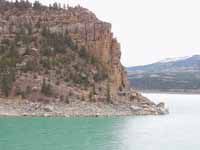| Joes Valley Reservoir sits at 41 percent of average. |
We tolerated cold winter days with snow laying on the ground most of the winter thinking that at least we would have plenty of water next summer. Now we find out the month of March played a mean trick on us. The warm dry days in March were so enjoyable after the cold winter, but they were a disaster to the mountain snow pack. Much of the mountain snow disappeared by evaporating or melting and soaking into the ground without providing much run off to the streams and reservoirs.
On March 1, the snow water equivalent on our watershed was 97 percent of average and on April 1, it had dropped to 48 percent of average. March really was harmful to our snow pack.
We lost so much of the mountain snow pack that we are now facing water shortages this summer worse than last year. April 1 is considered to be the date of the maximum snow accumulation in the mountains. After April 1, the snow levels begin declining and continue to go down until all of it is melted. A comparison of the snow water equivalents on April 1, this year and last year show that we have much less water this year and we are much lower than the average.
| Electric Lake sits well below its capacity. The spillway is high and dry with no end to the drought in sight. |
The Natural Resources Conservation Service (NRCS) makes predictions for the April to July stream flows. These stream flow forecasts are based upon the snow pack, soil moisture and other factors. Their forecasts show less runoff this year than last year. These forecasts are as follows:
The lower stream flow forecasts mean that we will have less water than we had last year. This means that the secondary irrigation systems will have restrictions again this year. The restrictions will be at least as tight as they were last year. Each city will determine their own restrictions, but don’t plan on watering during the hot daylight hours from 10 a.m. to 6 p.m., and expect to be limited to watering twice per week. Each city will notify their residents as to the specific restrictions that will be put in place.
The high hopes that we all had last winter for a good water year were all lost in March. March truly was disaster for the mountain snow pack as the drought continues.

